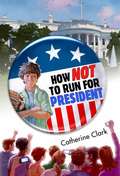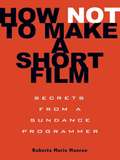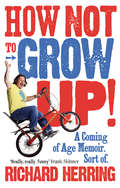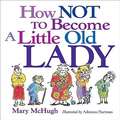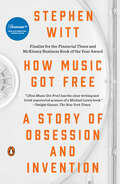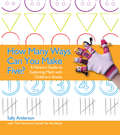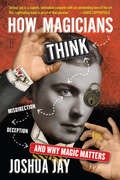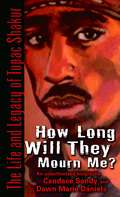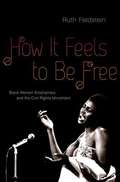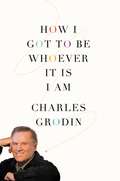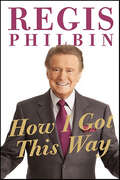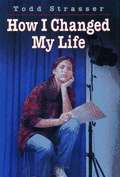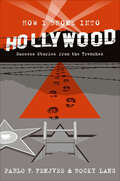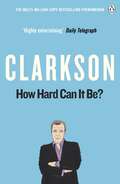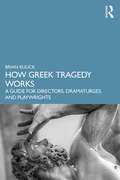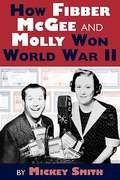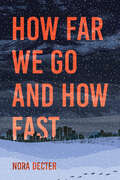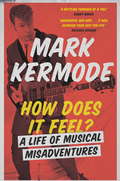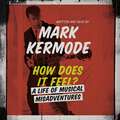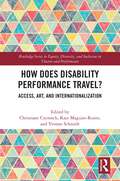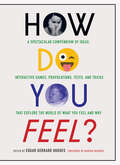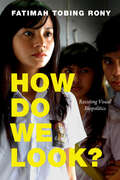- Table View
- List View
How Not To Run For President
by Catherine Clark"Humorous dialogue, smart pacing and some dirty politics make for an engaging read. With an election around the corner, this isn’t a bad way for young readers to view the political arena. "-Kirkus Reviews When the middle school band is called to play for a presidential campaign rally, Aidan is right there with his clarinet, just in time to save the candidate’s life. Interviewed by the media, he speaks up in favor of the need to save jobs-like his mom’s, for instance. Even though he’s in the middle of Little League season, for pete’s sake, the candidate convinces him to join her tour of the midwest. Problem 1: The candidate’s daughter HATES Aidan. Problem 2: What do you do when your whole life has been turned upside down and you can’t get away from the media? Problem 3: What’s a red-blooded American boy to do when he’s asked to play the clarinet on national TV and the local bully back home is giving interviews saying Aidan’s the nerd of the century?
How Not to Make a Short Film: Secrets from a Sundance Programmer
by Roberta Marie MunroeAnyone can make a short film, right? Just grab some friends and your handheld and you can do it in a weekend or two before being accepted to a slew of film festivals, right? Wrong. Roberta Munroe screened short film submissions at Sundance for five years, and is an award-winning short filmmaker in her own right. So she knows a thing or two about how not to make a short film. From the first draft of your script to casting, production, editing, and distribution, this is your one-stop primer for breaking into the business. Featuring interviews with many of today's most talented writers, producers, and directors, as well as revealing stories (e.g., what to do when the skinhead crack addict next door begins screaming obscenities as soon as you call "action") from the sets of her own short films, Roberta walks you through the minefield of mistakes that an aspiring filmmaker can make--so that you don't have to make them yourself.r breaking into the business. Featuring interviews with many of today's most talented writers, producers, and directors, as well as revealing stories (e.g., what to do when the skinhead crack addict next door begins screaming obscenities as soon as you call "action") from the sets of her own short films, Roberta walks you through the minefield of mistakes that an aspiring filmmaker can make--so that you don't have to make them yourself.
How Not to Grow Up: A Coming of Age Memoir. Sort of.
by Richard HerringComedian Richard Herring has a major problem. He's about to turn 40 and hasn't seen it coming. He's not married, doesn't have a proper job or 2.4 children. But now, finally, it looks as if the world expects him to be a grown up - and he's completely unprepared for it.As the momentous and terrifying event approaches (his birthday), Richard notices a steep decline in his own behaviour. Inexplicably he begins to behave more childishly - hanging out with 22-year-olds, developing an unhealthy addiction to Flumps and even getting into a ludicrous fight.How Not to Grow Up is the funny story of how a self-confessed perpetual Big Kid deals with his greatest fear - getting older - and is the perfect book for everyone who, deep down, still thinks that they're 18.
How Not to Become a Little Old Lady
by Mary MchughYou can be little, and you can be old, but that doesn't mean you have to be a Little Old Lady. We've all seen her. She's hunched forward, her blue hair is tucked neatly under a plastic rain bonnet, she's clutching expired coupons, and she's discussing her latest health problems over lunch. She's a Little Old Lady. . . and she's coming your way at two mph. Little Old Ladies have elastic waistbands on all their slacks. They save rubber bands, remember fifteen-cent McDonald's hamburgers, and have never seen a public rest room that was clean enough. How Not to Become a Little Old Lady is for any woman who is proud to have escaped Little Old Lady-hood, and it's for anyone in danger of slipping into those awful Little Old Lady tendencies.
How Music Got Free
by Stephen Witt"What happens when an entire generation commits the same crime?"How Music Got Free is a riveting story of obsession, music, crime, and money, featuring visionaries and criminals, moguls and tech-savvy teenagers. It's about the greatest pirate in history, the most powerful executive in the music business, a revolutionary invention and an illegal website four times the size of the iTunes Music Store. Journalist Stephen Witt traces the secret history of digital music piracy, from the German audio engineers who invented the mp3, to a North Carolina compact-disc manufacturing plant where factory worker Dell Glover leaked nearly two thousand albums over the course of a decade, to the high-rises of midtown Manhattan where music executive Doug Morris cornered the global market on rap, and, finally, into the darkest recesses of the Internet.Through these interwoven narratives, Witt has written a thrilling book that depicts the moment in history when ordinary life became forever entwined with the world online -- when, suddenly, all the music ever recorded was available for free. In the page-turning tradition of writers like Michael Lewis and Lawrence Wright, Witt's deeply-reported first book introduces the unforgettable characters--inventors, executives, factory workers, and smugglers--who revolutionized an entire artform, and reveals for the first time the secret underworld of media pirates that transformed our digital lives.An irresistible never-before-told story of greed, cunning, genius, and deceit, How Music Got Free isn't just a story of the music industry--it's a must-read history of the Internet itself.
How Music Got Free: The End of an Industry, the Turn of the Century, and the Patient Zero of Piracy
by Stephen WittFinalist for the 2016 Los Angeles Times Book Prize, the 2016 J. Anthony Lukas Book Prize, and the 2015 Financial Times and McKinsey Business Book of the YearA New York Times Editors' ChoiceONE OF THE YEAR'S BEST BOOKS: The Washington Post * The Financial Times * Slate * The Atlantic * Time * Forbes"[How Music Got Free] has the clear writing and brisk reportorial acumen of a Michael Lewis book."--Dwight Garner, The New York TimesWhat happens when an entire generation commits the same crime?How Music Got Free is a riveting story of obsession, music, crime, and money, featuring visionaries and criminals, moguls and tech-savvy teenagers. It's about the greatest pirate in history, the most powerful executive in the music business, a revolutionary invention and an illegal website four times the size of the iTunes Music Store. Journalist Stephen Witt traces the secret history of digital music piracy, from the German audio engineers who invented the mp3, to a North Carolina compact-disc manufacturing plant where factory worker Dell Glover leaked nearly two thousand albums over the course of a decade, to the high-rises of midtown Manhattan where music executive Doug Morris cornered the global market on rap, and, finally, into the darkest recesses of the Internet.Through these interwoven narratives, Witt has written a thrilling book that depicts the moment in history when ordinary life became forever entwined with the world online--when, suddenly, all the music ever recorded was available for free. In the page-turning tradition of writers like Michael Lewis and Lawrence Wright, Witt's deeply reported first book introduces the unforgettable characters--inventors, executives, factory workers, and smugglers--who revolutionized an entire artform, and reveals for the first time the secret underworld of media pirates that transformed our digital lives.An irresistible never-before-told story of greed, cunning, genius, and deceit, How Music Got Free isn't just a story of the music industry--it's a must-read history of the Internet itself.From the Hardcover edition.
How Many Zen Buddhists Does It Take to Screw in a Light Bulb?
by Matt Freedman Paul HoffmanExamples of the humor craze of the 1980s - the light bulb joke!
How Many Ways Can You Make Five?: A Parent's Guide to Exploring Math with Children's Books
by The Vermont Center for the Book Sally AndersonUse your child’s favorite books to explore and investigate the world of mathematics! In a world filled with patterns, shapes, sequences, and numbers – math is all around us. From an early age, children begin to notice and make connections between math concepts and everyday life, asking: How many? How high? How long? and How much does that weigh?Children’s books can bring math concepts to life. With the help of the stories and activities in How Many Ways Can You Make Five? you and your child will have a blast reading about, talking about, and exploring the world of math. Use favorite children’s books to investigate patterns and puzzles, learn how to subtract, and make maps.With four chapters that cover a multitude of themes, it’s never been easier to deepen your child’s understanding of important math and reading concepts at the same time!
How Magicians Think: Misdirection, Deception, and Why Magic Matters
by Joshua JayThe door to magic is closed, but it&’s not locked. And now Joshua Jay, one of the world&’s most accomplished magicians, not only opens that door but brings us inside to reveal the artistry and obsessiveness, esoteric history, and long-whispered-about traditions of a subject shrouded in mystery. And he goes one step further: Joshua Jay brings us right into the mind of a magician—how they develop their other worldly skills, conjure up illusions, and leave the rest of us slack jawed with delight time after time. Along the way, Jay reveals another kind of secret, one all readers will find meaningful even if they never aspire to perform sleight of hand: What does it take to follow your heart and achieve excellence? In 52 short, compulsively readable essays, Jay describes how he does it, whether it&’s through the making of illusions, the psychology behind them, or the way technology influences the world of magic. He considers the aesthetics of performance, discusses contemporary masters, including David Copperfield, Penn & Teller, and David Blaine, and details how magicians hone their craft. And answers questions like: Can a magic trick be too good? How do you saw a person in half? Is there real magic in the universe? The answers, like so much in magic and life, depend on you.
How Long Will They Mourn Me?: The Life and Legacy of Tupac Shakur
by Dawn Marie Daniels Candace Sandy"Buried as a g while tha whole world remembers me" -Tupac Shakur, from "Until the End of Time" Tupac Shakur was larger than life. A gifted rapper, actor, and poet, he was fearless, prolific, and controversial-and often said that he never expected to live past the age of thirty. He was right. On September 13, 1996, he died of gunshot wounds at age twenty-five. But even ten years after Tupac's tragic passing, the impact of his life and talent continues to flourish. Lauded as one of the greatest hip-hop artists of all time, Tupac has sold more than sixty-seven million records worldwide, making him the top-selling rapper ever. How Long Will They Mourn Me? celebrates Tupac's unforgettable life-his rise to fame; his tumultuous dark side marked by sex, drugs, and violence; and the indelible legacy he left behind. Although Tupac's murder remains unsolved, the spirit of this legendary artist is far from forgotten. How long will we mourn him? Fans worldwide will grieve his untimely death for a long time to come.
How it Feels to be Free: Black Women Entertainers and the Civil Rights Movement
by Ruth FeldsteinIn 1964 Nina Simone sat at a piano in New York's Carnegie Hall to play what she called a "show tune." Then she began to sing: "Alabama's got me so upset / Tennessee made me lose my rest / And everybody knows about Mississippi Goddam!" Simone, and her song, became icons of the civil rights movement. But her confrontational style was not the only path taken by black women entertainers. In How It Feels to Be Free, Ruth Feldstein examines celebrated black women performers, illuminating the risks they took, their roles at home and abroad, and the Ways that they raised the issue of gender amid their demands for black liberation. Feldstein focuses on six women who made names for themselves in the music, film, and television industries: Nina Simone, Lena Horne, Miriam Makeba, Abbey Lincoln, Diahann Carroll, and Cicely Tyson. These women did not simply mirror black activism; their performances helped constitute the era's political history. Makeba connected America's struggle for civil rights to the fight against apartheid in South Africa, while Simone sparked high-profile controversy with her incendiary lyrics. Yet Feldstein finds nuance in their careers. In 1968, Hollywood cast the outspoken Lincoln as a maid to a white family in For Love of Ivy, adding a layer of complication to the film. That same year, Diahann Carroll took on the starring role in the television series Julia. Was Julia a landmark for casting a black woman or for treating her race as unimportant? The answer is not clear-cut. Yet audiences gave broader meaning to what sometimes seemed to be apolitical performances. How It Feels to Be Free demonstrates that entertainment was not always just entertainment and that "We Shall Overcome" was not the only soundtrack to the civil rights movement. By putting black women performances at center stage, Feldstein sheds light on the meanings of black womanhood in a revolutionary time.
How I Got to Be Whoever It Is I Am
by Charles GrodinIn his candid and engaging new book HOW I GOT TO BE WHOEVER IT IS I AM, successful actor, author, and activist, Charles Grodin, looks back at the major events and private moments that have shaped his life. And, since Grodin is one of the best storytellers around, he can't help but entertain while offering insight gained from a wealth of experience. The combination of being impeached as class president by his fifth grade teacher (and then winning many school elections thereafter) with being thrown out of Hebrew School for asking too many questions (only to find a much better teacher as a result) informed Grodin's view of himself and made him adept at dealing with rejection--an important skill for an actor. Grodin's success in plays in high school and adventures in college theater led him to a career in acting, studying with the great teachers like Uta Hagen and Lee Strasberg. Grodin shares behind-the-scenes tales of working on plays like Same Time Next Year and movies like The Heartbreak Kid and Midnight Run--even how close he came to playing the lead in The Graduate.His stories feature the many actors, directors, writers, and producers, with whom he's worked, such as Robert DeNiro, Dustin Hoffman, Johnny Carson, Orson Welles, Warren Beatty, and other colorful characters. Grodin's greatest work isn't limited to stage and screen, however. He has been an award winning talk show host and commentator on Sixty Minutes II, and he reveals insights about the political and personal side of journalism and some of the larger-than-life characters he's interviewed. Still, it is the personal aspects of Grodin's life that are truly revealing and funny. He shares intimate anecdotes of humorous dating experiences during the carefree 70s along with stories of what it was like to be a young actor then with friends and colleagues like Robert Redford, Gene Wilder, and Dustin Hoffman. But it is Grodin's tales of the lives he's helped save with his relentless advocacy work that make you realize what a great guy Charles Grodin really is. We are lucky that the nice guy his friends call, "Chuck" brings us along to share a little of his journey of how he got to be who he really is!
How I Got This Way
by Regis PhilbinIn this entertaining memoir, the irrepressible "Reege" - consummate talk show host, man about town, loving husband, father, and yes, obsessive sports fan-looks back at his years in show business. One of the most popular television and cultural icons ever, Regis Philbin entertained television audiences for more than fifty years—as a beloved morning-show host (Live with Regis and Kelly), a nighttime game-show host (Who Wants to Be a Millionaire?) and also as a fixture on national and local late-night talk shows. The irrepressible “Reege” has regaled television audiences with his stories for more than half a century, but he’s saved the most hilarious, surprising, heartfelt, and inspiring tales for How I Got This Way. Both a fascinating show business memoir and a delightful primer for living the good life rolled into one, How I Got This Way is Reege being Reege, just the way we love him, as he shares the secrets to success and happiness that he has learned from his innumerable celebrity encounters, his close, personal friendships, and, of course, his relationship with his loving wife and family.
How I Changed My Life
by Todd StrasserA knee injury has left football star Kyle Winthrop sitting on the sidelines of high school life. Bolita Vine has vowed to change her image. She loses weight and works on becoming more assertive. She even lands the job of stage managing the school play. When Kyle tries out for the play, he and Bo become friends. But when Bo tries to take the relationship one step further, she soon learns the difference between fantasy and reality.
How I Broke into Hollywood: Success Stories from the Trenches
by Pablo F. Fenjves Rocky Lang“Inspiring…. Celebrity watchers will enjoy these vignettes, and Hollywood hopefuls will benefit from the advice.” — Library Journal“The collection of people ranges far and wide…buy it and take it with you to the beach.” — Filmstew.com
How Hard Can It Be?: The World According to Clarkson Volume 4 (The World According to Clarkson)
by Jeremy ClarksonHow Hard Can it Be? is the fourth hilarious volume in Jeremy Clarkson's The World According to Clarkson series.How hard can it be...To build a power station without upsetting the eco-mentalists? To seek world domination if you've been hit the ugly stick? For the Met Office to get yesterday's weather right?In volume four of The World According to Clarkson, Jeremy Clarkson pours scorn on the nonsensical, the dumb, the idiotic and the plain foolish in his continuing quest to discover where exactly we've all gone wrong.Along the way he ponders:• Whether conquering France might solve the immigration problem• What happened when you ignore proper warning labels • What would happen if we turned the internet offOften controversial, frequently scathing but always funnier than James May, Jeremy Clarkson shows us how we could so easily make the world a better place. Praise for Jeremy Clarkson:'Brilliant . . . laugh-out-loud' Daily Telegraph'Outrageously funny . . . will have you in stitches' Time OutNumber-one bestseller Jeremy Clarkson writes on cars, current affairs and anything else that annoys him in his sharp and funny collections. Born To Be Riled, Clarkson On Cars, Don't Stop Me Now, Driven To Distraction, Round the Bend, Motorworld, and I Know You Got Soul are also available as Penguin paperbacks; the Penguin App iClarkson: The Book of Cars can be downloaded on the App Store.Jeremy Clarkson because his writing career on the Rotherham Advertiser. Since then he has written for the Sun and the Sunday Times. Today he is the tallest person working in British television, and is the presenter of the hugely popular Top Gear.
How Greek Tragedy Works: A Guide for Directors, Dramaturges, and Playwrights
by Brian KulickHow Greek Tragedy Works is a journey through the hidden meanings and dual nature of Greek tragedy, drawing on its foremost dramatists to bring about a deeper understanding of how and why to engage with these enduring plays. Brian Kulick dispels the trepidation that many readers feel with regard to classical texts by equipping them with ways in which they can unpack the hidden meanings of these plays. He focuses on three of the key texts of Greek theatre: Aeschylus' Agamemnon, Euripides' The Bacchae, and Sophocles' Electra, and uses them to tease out the core principles of the theatre-making and storytelling impulses. By encouraging us to read between the lines like this, he also enables us to read these and other Greek tragedies as artists' manifestos, equipping us not only to understand tragedy itself, but also to interpret what the great playwrights had to say about the nature of plays and drama. This is an indispensable guide for anyone who finds themselves confronted with tackling the Greek classics, whether as a reader, scholar, student, or director.
How Fibber Mcgee and Molly Won World War II
by Mickey C. SmithA detailed account with notes about the Fibber McGee and Molly show and its relationship to the Johnson wax company during World War II.
How Far We Go and How Fast
by Nora DecterSixteen-year-old Jolene, named after the girl in the Dolly Parton song, is from a long line of lowlifes, but at least they're musical lowlifes. Her mother is a tanning-salon manager who believes she can channel her karaoke habit into a professional singing career. Jolene's dad, a failed bass player, has gone back to the family demolition business and lives by the company motto: "We do not build things; we only tear them down." But Jolene and her big brother, Matt, are true musicians, writing songs together that make everything Jo hates about their lives matter less. <P><P>When Matt up and leaves in the middle of the night, Jo loses her only friend, her support system and the one person who made her feel cool. As it becomes clear that Matt is never coming back, Jo must use music to navigate her loss.
How Does It Feel?: A Life of Musical Misadventures
by Mark Kermode'Wonderful - such a terrific read. Brilliantly captures the passion, commitment, searing self-knowledge and dizzy happiness that comes with loving music. An enchanting book' STEPHEN FRY***Following a formative encounter with the British pop movie Slade in Flame in 1975, Mark Kermode decided that musical superstardom was totally attainable. And so, armed with a homemade electric guitar and very little talent, he embarked on an alternative career - a chaotic journey which would take him from the halls and youth clubs of North London to the stages of Glastonbury, the London Palladium and The Royal Albert Hall. Hilarious and blissfully nostalgic, this is a riotous account of a bedroom dreamer's attempts to conquer the world armed with nothing more than a chancer's enthusiasm and a simple philosophy: how hard can it be? *** 'At the heart of this entertaining memoir is a little boy in his back garden in Finchley, banging out a rhythm on saucepans with a couple of wooden spoons' Daily Mail'A rocking whirlwind of a tale' DANNY BAKER'Wonderful . . . will increase your zest for life' RICHARD AYOADE'Entertaining . . . what comes through every anecdote is the author's genuine enthusiasm for music' Spectator
How Does It Feel?: A Life of Musical Misadventures
by Mark KermodeFollowing a formative encounter with the British pop movie Slade in Flame in 1975, Mark Kermode decided that musical superstardom was totally attainable. And so, armed with a homemade electric guitar and very little talent, he embarked on an alternative career - a chaotic journey which would take him from the halls and youth clubs of North London to the stages of Glastonbury, the London Palladium and The Royal Albert Hall.HOW DOES IT FEEL? follows a lifetime of musical misadventures which have seen Mark striking rockstar poses in the Sixth Form Common Room, striding around a string of TV shows dressed from head to foot in black leather, getting heckled off stage by a bunch of angry septuagenarians on a boat on the Mersey, showing Timmy Mallet how to build a tea-chest bass - and winning the International Street Entertainers of the Year award as part of a new wave of skiffle. Really. Hilarious, self-deprecating and blissfully nostalgic, this is a riotous account of a bedroom dreamer's attempts to conquer the world armed with nothing more than a chancer's enthusiasm and a simple philosophy: how hard can it be?
How Does It Feel?: A Life of Musical Misadventures
by Mark KermodeFollowing a formative encounter with the British pop movie Slade in Flame in 1975, Mark Kermode decided that musical superstardom was totally attainable. And so, armed with a homemade electric guitar and very little talent, he embarked on an alternative career - a chaotic journey which would take him from the halls and youth clubs of North London to the stages of Glastonbury, the London Palladium and The Royal Albert Hall.HOW DOES IT FEEL? follows a lifetime of musical misadventures which have seen Mark striking rockstar poses in the Sixth Form Common Room, striding around a string of TV shows dressed from head to foot in black leather, getting heckled off stage by a bunch of angry septuagenarians on a boat on the Mersey, showing Timmy Mallet how to build a tea-chest bass - and winning the International Street Entertainers of the Year award as part of a new wave of skiffle. Really. Hilarious, self-deprecating and blissfully nostalgic, this is a riotous account of a bedroom dreamer's attempts to conquer the world armed with nothing more than a chancer's enthusiasm and a simple philosophy: how hard can it be?Written and Read by Mark KermodeMusic samples from the album 'Drive Train' are reproduced with kind permission from The Dodge Brothers(P) Orion Publishing Group 2018
How Does Disability Performance Travel?: Access, Art, and Internationalization (Routledge Series in Equity, Diversity, and Inclusion in Theatre and Performance)
by Christiane Czymoch Kate Maguire-Rosier Yvonne SchmidtThis edited collection investigates the myriad ways in which disability performance travels in a globalized world. Disability arts festivals are growing in different parts of the world; theatre and dance companies with disabled artists are increasingly touring and collaborating with international partners. At the same time, theatre spaces are often not accessible, and the necessity of mobility excludes some disabled artists from being part of an international disability arts community. How does disability performance travel, who does not travel – and why? What is the role of funding and producing structures, disability arts festivals and networks around the world? How do the logics of international (co-)producing govern the way in which disability art is represented internationally? Who is excluded from being part of a touring theatre or dance company, and how can festivals, conferences, and other agents of a growing disability culture create other forms of participation, which are not limited to physical co-presence? This study will contextualize disability aesthetics, arts, media, and culture in a global frame, yet firmly rooted in its smaller national, state, and local community settings and will be of great interest to students and scholars in the field.
How Do You Feel?: Understand Your Emotions through Charts, Tests, Questionnaires, and Interactive Games
by Edgar Gerrard HughesAn insightful and fun interactive guide to understanding the what, how, and why of your emotions.Almost every moment of our lives is suffused with emotion, yet we rarely think about what these emotions mean, how they're formed, and how to address them. How Do You Feel? gathers decades of recent research on emotions in accessible short essays and engaging activities that let you be your own guide in learning about your emotions. With questionnaires, quizzes, assessments, and more, How Do Your Feel? is great for groups or individuals, and will entertain, inform, surprise, and help you get to know yourself better.
How Do We Look?: Resisting Visual Biopolitics (a Camera Obscura book)
by Fatimah Tobing RonyIn How Do We Look? Fatimah Tobing Rony draws on transnational images of Indonesian women as a way to theorize what she calls visual biopolitics—the ways visual representation determines which lives are made to matter more than others. Rony outlines the mechanisms of visual biopolitics by examining Paul Gauguin’s 1893 portrait of Annah la Javanaise—a trafficked thirteen-year-old girl found wandering the streets of Paris—as well as US ethnographic and documentary films. In each instance, the figure of the Indonesian woman is inextricably tied to discourses of primitivism, savagery, colonialism, exoticism, and genocide. Rony also focuses on acts of resistance to visual biopolitics in film, writing, and photography. These works, such as Rachmi Diyah Larasati’s The Dance that Makes You Vanish, Vincent Monnikendam’s Mother Dao (1995), and the collaborative films of Nia Dinata, challenge the naturalized methods of seeing that justify exploitation, dehumanization, and early death of people of color. By theorizing the mechanisms of visual biopolitics, Rony elucidates both its violence and its vulnerability.
